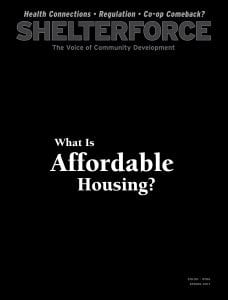
How Should We Measure Housing Affordability?
The simplicity of the 30 percent standard is also its downfall. We don’t expect people of differing incomes or family sizes to pay the same percentage of their income in taxes—why would the same percentage work for housing costs?

Vision, Not Just Critique
In the Spring 2017 issue of Shelterforce, we talk about something that comes up daily for many people working in the community development field—what does housing affordability mean? Crafting practical policies to back up our vision requires that we be thoughtful about all of the pieces.

Lawn Sign Liberalism
If you live anywhere with a substantial resistance to the current administration’s attacks on immigrants, you may have seen these lawn/window signs–they say, in Spanish, English, and Arabic, “No matter […]

Local Contracting–Cost Cutting, Economic Development, Or Both?
We recently published both an article and an Answer column that shows how one group in Philadelphia, WPRE/NR, is challenging the conventional wisdom that scattered site, small-unit rehab has to […]

Regulation and Housing Supply: Where the Left & Right Agree (Sort Of)
We gathered some people who have done a lot of thinking and studying on regulation to discuss what it might look like to actually remove obstacles that get in the way of developing less expensive housing options responsibly. What’s possible? What are the trade-offs?

Preliminary HUD Budget Shows Carson Lied in His Confirmation Hearing Too
The Washington Post reported today that a preliminary HUD budget cuts $6 billion—eliminating Community Development Block Grants (CDBG) and the HOME program, and cutting the already inadequate public housing operating […]

Carson Confirmed. So About Those Other HUD Jobs…
Ben Carson has been confirmed as secretary of the U.S. Department of Housing and Urban Development (HUD) to the weak congratulations of housing organizations that didn’t want to waste their political […]

Nonprofits–Yes You Can Advocate. And Now’s The Time
Amidst the chaos of the past couple weeks there has been at least one positive change—a lot more people are starting to stand up and speak out about issues that […]

Interview with Rinku Sen, president and executive director of Race Forward & publisher of Colorlines.com
In those exhausting and frightening days right after the election in November, I had the good fortune to catch Rinku Sen for a few minutes at the end of a long day of her organization’s biannual Facing Race conference. Though she must have been running on next to no sleep by that point, Sen was insightful, earnest, and eager to talk about the road ahead.

Carson Tries to Please Everyone in Confirmation Hearing, Mostly Succeeds
Triage is in effect among those opposed to the incoming administration and the president-elect's cabinet picks. This morning’s Senate hearing for Ben Carson was not a exercise in determining whether […]

GOP Tax Plan Takes Mortgage Interest Deduction Unfairness Off the Charts
Let’s raise the standard deduction and lower tax rates to give everyone a tax cut! It should not surprise you that since this is a description of the House GOP […]

Bringing Together Arts and Community Development
Who has been behind the large increase in financial support for and attention to what has been termed “creative placemaking” over the past couple years, and why?
